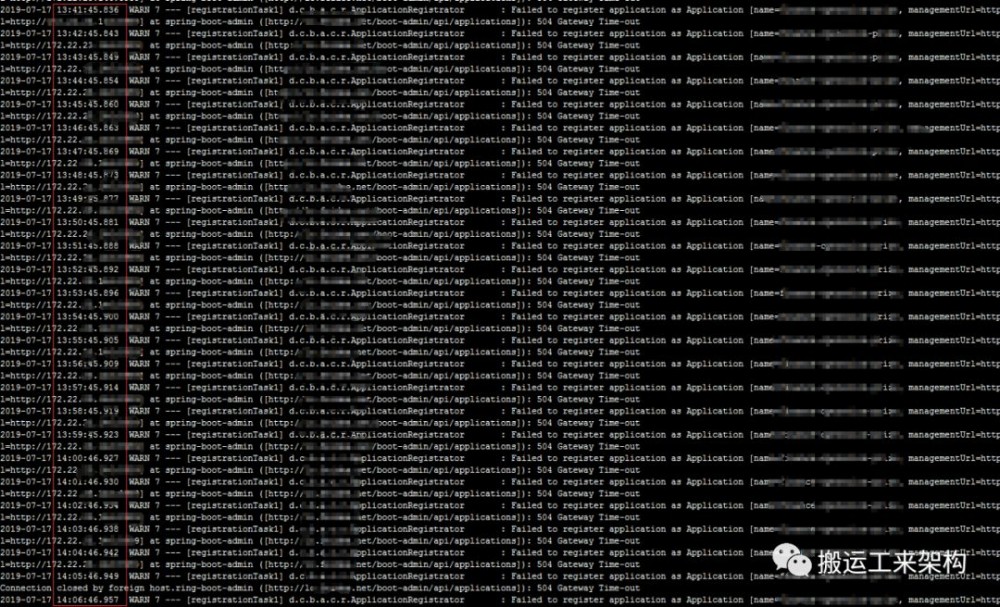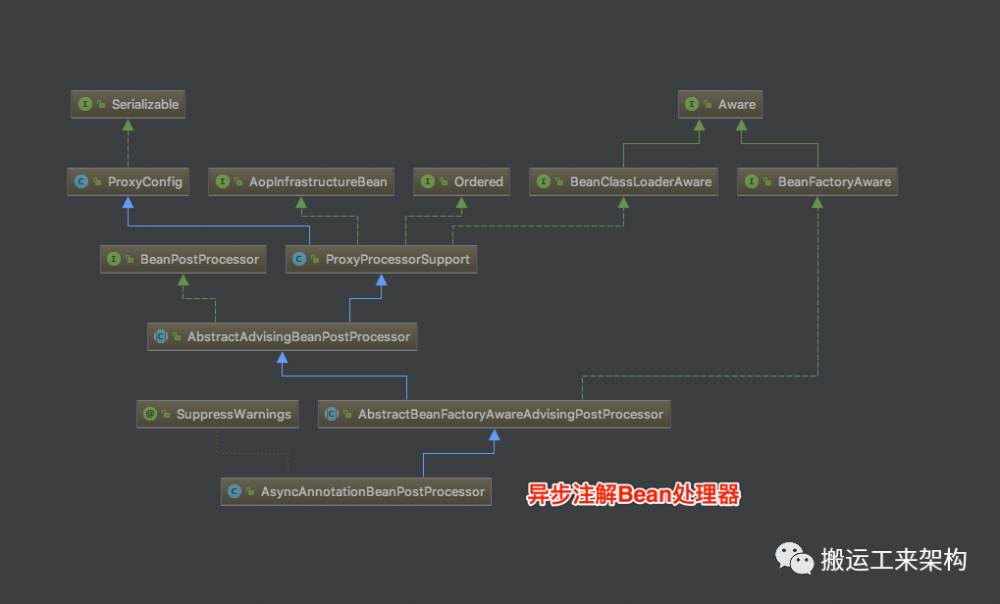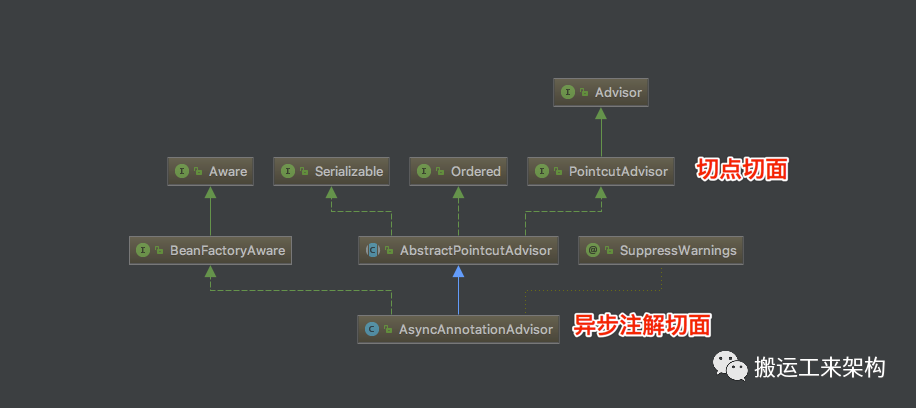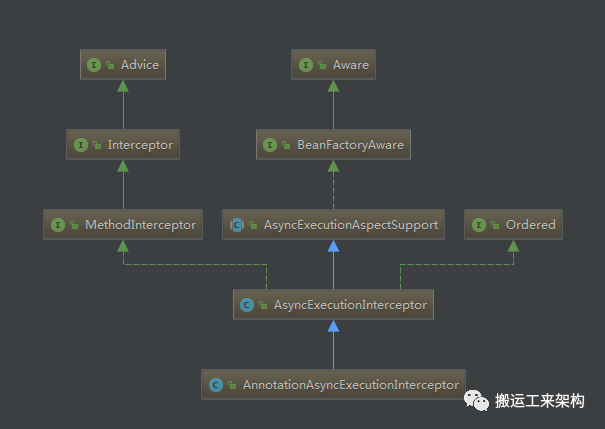这次事故不仅仅是RestTemplate的锅还有@Async

点击上方蓝色字关注我们~
分享一下遇到的坑,文章篇幅偏长,希望对你有帮助。
一、背景
某一天,测试同学向我 反馈 :
测试环境上已使用的1张优惠券,为什么还会出现在可用列表里,然后再次选择优惠券,点击使用的时候,提示: 该券已被使用,不能重复使用 。
我的第一反应:应该不会吧,生产上这个 功能一直正常 ,如果生产上出现这个问题不得炸了锅?所以,我就跟测试同学说,你是不是做了什么特殊操作?因为我使用了 缓存 ,所以我问他有没有直接修改数据库相关记录,会不会是因为这样操作造成缓存数据不一致问题?他说没有,其他人使用也出现这个问题。
我就很奇怪我,程序员的直觉: 不相信! 不~可能!
然后我就麻烦测试同学在测试环境重现一下这个问题,我一直盯着他操作,然后确实在我面前出现了 ~囧~ 。
由于这个功能在生产已经很长时间了,一直没人反馈有什么问题,所以百思不得其解。
也许, 这是一个潜在的bug???
二、项目技术介绍
涉及相关的框架或技术: Springboot、RestTemplate、Redis、异步、RocketMQ 。
三、抽丝剥茧——排查问题
1、重启大法,清除缓存,防止数据不一致。
由于怀疑是数据不一致造成的,所以让测试同学帮忙验证排除是否因为这个问题造成的。当测试重启之后也清除相关缓存数据,重新重现操作。
这时发现,好像都正常了?难道问题就是这个原因?所以当时觉得原因应该就是这样了。
2、问题又来了
正常一段时间之后, 问题又出现了 !为什么,疑惑ing...。
这个是一个很奇怪的问题,然后我仔细把代码过了一遍。
主要是检查了跟优惠券相关的使用逻辑、缓存策略。
由于我们使用RocketMQ作为消息队列,Redis作为缓存,优惠券缓存在Redis,过期时间1小时。
所以当券的变更之后,我会将缓存里的数据进行清除,尽最大可能达到数据一致性。
而且发现,在发送消息的时候,由于我们的消息组件使用的是同步发送(目前暂不支持异步发送),所以我们处理业务的时候增加了异步处理,看到发送sendMsg方法上使用的是Spring提供的@Async异步注解实现异步。
(对于Spring @Async注解相关功能此次不做详细的阐述。有兴趣的同学可以自行查阅相关资料,或者点击文末提供的参考链接)
3、排查罪魁祸首——@Async异步注解 ?
查阅了相关的资料,有的说可能是你的使用方式不对造成异步无效:
①、没有在启动类或者配置类增加@EnableAsync开启注解;
②、同一类内,方法A、方法B之间进行内部调用,A-》B,B使用@Async注解,由于这种没有使用到代理,异步不生效。
以上是大家遇到比较多的原因。
所以我这边也着重看了下我们的使用方式,并且验证了是否真的是以异步的方式进行调用。
4、进一步发现可疑点
排除了@Async的使用问题。这时我又继续观察日志,又有了可疑的地方!因为我们是使用Springboot,并且还有Springboot admin来监控应用服务,方便查看相关内存、线程、日志等信息。
这时发现应用日志打印如下:
WARN 7 --- [gistrationTask1] d.c.b.a.c.r.ApplicationRegistrator : Failed to register application as Application
[name=App, managementUrl=http://ip:port, healthUrl=http://ip:port/health, serviceUrl=http://ip:port] at spring-boot-admin ([http://test.com/boot-admin/api/applications]): 504 Gateway Time-out
这个日志一直在打印,并且都是间隔一段时间进行打印。

上面的日志间隔打印是1分钟,为什么是1分钟,下面我会提到。这里先做个伏笔。
此时,有点怀疑,但是又不确定也觉得不太可能是这个造成的吧?似乎关联性不大。
所以让相关同学把对应的springboot-admin应用起起来,尽量排除相关不确定因素吧。
同学把springboot-admin起起来之后,我这边继续观察日志,这时 奇迹 出现了,之前没打印的日志此时打印出来了,并且打印的似乎是之前应该早就执行逻辑并且打印相关的日志。
并且发现执行应用注册到springboot-admin的日志打印的线程信息与我使用@Async注解异步发送消息的线程名是同一个?为什么?这两个怎么会使用同一个线程或线程池?@Async不是会有自己的线程池吗?
5、剖析源码——springboot-admin client应用注册
@Bean
@ConditionalOnMissingBean
public RegistrationApplicationListener registrationListener(AdminProperties admin,
ApplicationRegistrator registrator) {
// 注册应用监听器,使用ThreadPoolTaskScheduler,核心线程数为1
RegistrationApplicationListener listener = new RegistrationApplicationListener(registrator,
registrationTaskScheduler());
listener.setAutoRegister(admin.isAutoRegistration());
listener.setAutoDeregister(admin.isAutoDeregistration());
listener.setRegisterPeriod(admin.getPeriod());
return listener;
}
// 初始化任务定时器-线程池,核心线程数1,线程名前缀registrationTask,与日志打印的线程信息一致。
@Bean
@Qualifier("registrationTaskScheduler")
public TaskScheduler registrationTaskScheduler() {
ThreadPoolTaskScheduler taskScheduler = new ThreadPoolTaskScheduler();
taskScheduler.setPoolSize(1);
taskScheduler.setRemoveOnCancelPolicy(true);
taskScheduler.setThreadNamePrefix("registrationTask");
return taskScheduler;
}
由初始化入口得知,客户端应用注册到springboot-admin使用的类是RegistrationApplicationListener监听器,并且初始化了定时调度器线程池,核心线程数为1,线程名前缀是:registrationTask。
/**
* Listener responsible for starting and stopping the registration task when the application is
* ready.
*
* @author Johannes Edmeier
*/
public class RegistrationApplicationListener {
private static final Logger LOGGER = LoggerFactory
.getLogger(RegistrationApplicationListener.class);
private final ApplicationRegistrator registrator;
private final TaskScheduler taskScheduler;
private boolean autoDeregister = false;
private boolean autoRegister = true;
private long registerPeriod = 10_000L;
private volatile ScheduledFuture<?> scheduledTask;
public RegistrationApplicationListener(ApplicationRegistrator registrator,
TaskScheduler taskScheduler) {
this.registrator = registrator;
this.taskScheduler = taskScheduler;
}
// 使用事件监听器-spring的事件监听机制
@EventListener
@Order(Ordered.LOWEST_PRECEDENCE)
public void onApplicationReady(ApplicationReadyEvent event) {
if (event.getApplicationContext() instanceof WebApplicationContext && autoRegister) {
//启动注册任务
startRegisterTask();
}
}
// 监听关闭事件,关闭注册任务,注册器注销
@EventListener
@Order(Ordered.LOWEST_PRECEDENCE)
public void onClosedContext(ContextClosedEvent event) {
if (event.getApplicationContext() instanceof WebApplicationContext) {
stopRegisterTask();
if (autoDeregister) {
registrator.deregister();
}
}
}
public void startRegisterTask() {
if (scheduledTask != null && !scheduledTask.isDone()) {
return;
}
// 注册器固定间进行注册操作,这里registerPeriod间隔时间默认是10秒,可以通过spring.admin.client.period进行动态配置设置。
scheduledTask = taskScheduler.scheduleAtFixedRate(new Runnable() {
@Override
public void run() {
registrator.register();
}
}, registerPeriod);
LOGGER.debug("Scheduled registration task for every {}ms", registerPeriod);
}
public void stopRegisterTask() {
if (scheduledTask != null && !scheduledTask.isDone()) {
scheduledTask.cancel(true);
LOGGER.debug("Canceled registration task");
}
}
...省略
}
从以上源码得知,注册任务是通过调度器按照默认10秒固定时间间隔频率进行调用。
接下来我们继续看 注册逻辑 :
/**
* Registers the client application at spring-boot-admin-server
*/
public class ApplicationRegistrator {
private final AtomicReference<String> registeredId = new AtomicReference<>();
private final AdminProperties admin;
private final RestTemplate template;
private final ApplicationFactory applicationFactory;
/**
* Registers the client application at spring-boot-admin-server.
*
* @return true if successful registration on at least one admin server
*/
public boolean register() {
boolean isRegistrationSuccessful = false;
Application self = createApplication();
for (String adminUrl : admin.getAdminUrl()) {
try {
// 使用RestTemplate调用springboot-admin进行注册
@SuppressWarnings("rawtypes")
ResponseEntity<Map> response = template.postForEntity(adminUrl,
new HttpEntity<>(self, HTTP_HEADERS), Map.class);
if (response.getStatusCode().equals(HttpStatus.CREATED)) {
if (registeredId.compareAndSet(null, response.getBody().get("id").toString())) {
LOGGER.info("Application registered itself as {}", response.getBody());
} else {
LOGGER.debug("Application refreshed itself as {}", response.getBody());
}
isRegistrationSuccessful = true;
// 只需要往一个admin注册,则注册完成之后跳出for循环。
if (admin.isRegisterOnce()) {
break;
}
} else {
LOGGER.warn("Application failed to registered itself as {}. Response: {}", self,
response.toString());
}
} catch (Exception ex) {
//重点:注册时出现的异常日志打印,也就是我们关注的地方
LOGGER.warn("Failed to register application as {} at spring-boot-admin ({}): {}",
self, admin.getAdminUrl(), ex.getMessage());
}
}
return isRegistrationSuccessful;
}
...省略部分代码
}
通过以上的代码,我们知道实现起来挺简单:使用定时任务调度注册任务,并且使用RestTemplate进行HTTP调用注册接口,如果注册过程出现异常(可能网络异常),此时会打印相关的异常告警日志。也就是我们上面的日志信息。
但是这里怎么会造成我们本次“事故”的原因呢?似乎还没有找到最终根源,还破解不了谜题。
那我们继续往下探究吧!
6、剖析源码——又是RestTemplate的锅?
关于RestTemplate的坑,网上也出现了不少的文章。
大部分都是因为使用默认的配置方式,没有设置超时时间从而引发的“血案”!这里可以看下这个案例:《 RestTemplate超时引发的血案 》
// RestTemplate执行HTTP的关键方法
// org.springframework.web.client.RestTemplate#doExecute
protected <T> T doExecute(URI url, HttpMethod method, RequestCallback requestCallback,
ResponseExtractor<T> responseExtractor) throws RestClientException {
Assert.notNull(url, "'url' must not be null");
Assert.notNull(method, "'method' must not be null");
ClientHttpResponse response = null;
try {
// 创建Request请求
ClientHttpRequest request = createRequest(url, method);
if (requestCallback != null) {
requestCallback.doWithRequest(request);
}
response = request.execute();
handleResponse(url, method, response);
if (responseExtractor != null) {
return responseExtractor.extractData(response);
}
else {
return null;
}
}
catch (IOException ex) {
String resource = url.toString();
String query = url.getRawQuery();
resource = (query != null ? resource.substring(0, resource.indexOf('?')) : resource);
throw new ResourceAccessException("I/O error on " + method.name() +
" request for /"" + resource + "/": " + ex.getMessage(), ex);
}
finally {
if (response != null) {
response.close();
}
}
}
// 通过工厂的方式创建Request
protected ClientHttpRequest createRequest(URI url, HttpMethod method) throws IOException {
ClientHttpRequest request = getRequestFactory().createRequest(url, method);
if (logger.isDebugEnabled()) {
logger.debug("Created " + method.name() + " request for /"" + url + "/"");
}
return request;
}
// 默认工厂类
private ClientHttpRequestFactory requestFactory = new SimpleClientHttpRequestFactory();
通过以上方法,我们知道HTTP Request请求是通过工厂创建,其实RestTemplate支持OkHttp、HttpClient、JDK HttpURLConnection等各种方式进行HTTP请求处理。
我们继续看到底是用 哪种方式 :
默认工厂实现类是SimpleClientHttpRequestFactory,通过查看该类的实现,我们知道这个是JDK的标准HTTP处理类,调用了HttpURLConnection进行HTTP请求处理。
同时,我们也看到HttpClient对应的工厂类:HttpComponentsAsyncClientHttpRequestFactory;OkHttp对应的工厂类:OkHttpClientHttpRequestFactory,还有Netty4等等。
此时,将“异常”线程堆栈进行导出:
"registrationTask1" #204 prio=5 os_prio=0 tid=0x00007f09b1865000 nid=0xd6 runnable [0x00007f091a7bb000]
java.lang.Thread.State: RUNNABLE
at java.net.SocketInputStream.socketRead0(Native Method)
at java.net.SocketInputStream.socketRead(SocketInputStream.java:116)
at java.net.SocketInputStream.read(SocketInputStream.java:171)
at java.net.SocketInputStream.read(SocketInputStream.java:141)
at java.io.BufferedInputStream.fill(BufferedInputStream.java:246)
at java.io.BufferedInputStream.read1(BufferedInputStream.java:286)
at java.io.BufferedInputStream.read(BufferedInputStream.java:345)
- locked <0x00000000f7a0bc78> (a java.io.BufferedInputStream)
at sun.net.www.http.HttpClient.parseHTTPHeader(HttpClient.java:735)
at sun.net.www.http.HttpClient.parseHTTP(HttpClient.java:678)
at sun.net.www.protocol.http.HttpURLConnection.getInputStream0(HttpURLConnection.java:1587)
- locked <0x00000000f7a024f8> (a sun.net.www.protocol.http.HttpURLConnection)
at sun.net.www.protocol.http.HttpURLConnection.getInputStream(HttpURLConnection.java:1492)
- locked <0x00000000f7a024f8> (a sun.net.www.protocol.http.HttpURLConnection)
at java.net.HttpURLConnection.getResponseCode(HttpURLConnection.java:480)
at org.springframework.http.client.SimpleClientHttpResponse.getRawStatusCode(SimpleClientHttpResponse.java:52)
at org.springframework.web.client.DefaultResponseErrorHandler.hasError(DefaultResponseErrorHandler.java:50)
at org.springframework.web.client.RestTemplate.handleResponse(RestTemplate.java:696)
at org.springframework.web.client.RestTemplate.doExecute(RestTemplate.java:661)
at org.springframework.web.client.RestTemplate.execute(RestTemplate.java:621)
at org.springframework.web.client.RestTemplate.postForEntity(RestTemplate.java:415)
at de.codecentric.boot.admin.client.registration.ApplicationRegistrator.register(ApplicationRegistrator.java:69)
at de.codecentric.boot.admin.client.registration.RegistrationApplicationListener$1.run(RegistrationApplicationListener.java:80)
at org.springframework.scheduling.support.DelegatingErrorHandlingRunnable.run(DelegatingErrorHandlingRunnable.java:54)
at java.util.concurrent.Executors$RunnableAdapter.call(Executors.java:511)
at java.util.concurrent.FutureTask.runAndReset(FutureTask.java:308)
at java.util.concurrent.ScheduledThreadPoolExecutor$ScheduledFutureTask.access$301(ScheduledThreadPoolExecutor.java:180)
at java.util.concurrent.ScheduledThreadPoolExecutor$ScheduledFutureTask.run(ScheduledThreadPoolExecutor.java:294)
at java.util.concurrent.ThreadPoolExecutor.runWorker(ThreadPoolExecutor.java:1149)
at java.util.concurrent.ThreadPoolExecutor$Worker.run(ThreadPoolExecutor.java:624)
at java.lang.Thread.run(Thread.java:748)
又将正常时的堆栈进行导出:
"registrationTask1" #219 prio=5 os_prio=0 tid=0x00007fcfa481e800 nid=0xe5 waiting on condition [0x00007fcefae38000]
java.lang.Thread.State: TIMED_WAITING (parking)
at sun.misc.Unsafe.park(Native Method)
- parking to wait for <0x00000000f5940818> (a java.util.concurrent.locks.AbstractQueuedSynchronizer$Condit
at java.util.concurrent.locks.LockSupport.parkNanos(LockSupport.java:215)
at java.util.concurrent.locks.AbstractQueuedSynchronizer$ConditionObject.awaitNanos(AbstractQueuedSynchroni
at java.util.concurrent.ScheduledThreadPoolExecutor$DelayedWorkQueue.take(ScheduledThreadPoolExecutor.java:
at java.util.concurrent.ScheduledThreadPoolExecutor$DelayedWorkQueue.take(ScheduledThreadPoolExecutor.java:
at java.util.concurrent.ThreadPoolExecutor.getTask(ThreadPoolExecutor.java:1074)
at java.util.concurrent.ThreadPoolExecutor.runWorker(ThreadPoolExecutor.java:1134)
at java.util.concurrent.ThreadPoolExecutor$Worker.run(ThreadPoolExecutor.java:624)
at java.lang.Thread.run(Thread.java:748)
知道了在JDK http请求网络时出现线程处于runnable。
可以看出,如果没有设置超时参数,线程在网络请求时可能会造成一直RUNNABLE,通过多次线程堆栈的导出,线程一直处于RUNNABLE,那么其它共用同一线程池的可能就没法执行处理了。比如此案例,通过@Async注解使用的线程池就是同一个,为什么?
下面我会分析。
通过上面的简单的过了一下代码,我们大致也了解了。根据经验,我们知道相关HTTP如果没有进行相关超时参数设置,会造成我们的服务经常请求超时,并且容易拖垮我们的应用服务。具体的解决方案网上很多,有兴趣者可自行Google一下。
通过这种“事故”,我们也知道 了要规避犯这种错误,一般会要求: 设置相关超时参数,比如connectTimeot、readTimeout等等 ,防止请求一直占用系统资源,从而将服务拖垮。
7、剖析源码——@Async注解
@Target(ElementType.TYPE)
@Retention(RetentionPolicy.RUNTIME)
@Documented
@Import(AsyncConfigurationSelector.class)
public @interface EnableAsync {}
使用注解EnableAsync开启Async异步注解功能。继续往AsyncConfigurationSelector这个类看:
public class AsyncConfigurationSelector extends AdviceModeImportSelector<EnableAsync> {
private static final String ASYNC_EXECUTION_ASPECT_CONFIGURATION_CLASS_NAME =
"org.springframework.scheduling.aspectj.AspectJAsyncConfiguration";
/**
* {@inheritDoc}
* @return {@link ProxyAsyncConfiguration} or {@code AspectJAsyncConfiguration} for
* {@code PROXY} and {@code ASPECTJ} values of {@link EnableAsync#mode()}, respectively
*/
@Override
public String[] selectImports(AdviceMode adviceMode) {
switch (adviceMode) {
case PROXY: // Proxy模式,使用的是ProxyAsyncConfiguration
return new String[] { ProxyAsyncConfiguration.class.getName() };
case ASPECTJ: // ASPECT模式,使用的是AspectJAsyncConfiguration
return new String[] { ASYNC_EXECUTION_ASPECT_CONFIGURATION_CLASS_NAME };
default:
return null;
}
}
}
通过selectImports机制(具体请查看相关资料),这里我们从ProxyAsyncConfiguration源码着手:
@Configuration
@Role(BeanDefinition.ROLE_INFRASTRUCTURE)
public class ProxyAsyncConfiguration extends AbstractAsyncConfiguration {
//生成AsyncAnnotationBeanPostProcessor实例,并且设置:异步注解类型、执行器、异常处理器等。
@Bean(name = TaskManagementConfigUtils.ASYNC_ANNOTATION_PROCESSOR_BEAN_NAME)
@Role(BeanDefinition.ROLE_INFRASTRUCTURE)
public AsyncAnnotationBeanPostProcessor asyncAdvisor() {
Assert.notNull(this.enableAsync, "@EnableAsync annotation metadata was not injected");
//新建一个异步注解bean后处理器
AsyncAnnotationBeanPostProcessor bpp = new AsyncAnnotationBeanPostProcessor();
Class<? extends Annotation> customAsyncAnnotation = this.enableAsync.getClass("annotation");
if (customAsyncAnnotation != AnnotationUtils.getDefaultValue(EnableAsync.class, "annotation")) {
//如果@EnableAsync中用户自定义了annotation属性,即异步注解类型,那么设置
bpp.setAsyncAnnotationType(customAsyncAnnotation);
}
if (this.executor != null) {
// 设置线程任务执行器
bpp.setExecutor(this.executor);
}
if (this.exceptionHandler != null) {
// 设置异常处理器
bpp.setExceptionHandler(this.exceptionHandler);
}
//设置是否升级到CGLIB子类代理,默认不开启
bpp.setProxyTargetClass(this.enableAsync.getBoolean("proxyTargetClass"));
//设置执行优先级,默认最后执行
bpp.setOrder(this.enableAsync.<Integer>getNumber("order"));
return bpp;
}
}
@Configuration
public abstract class AbstractAsyncConfiguration implements ImportAware {
protected AnnotationAttributes enableAsync;
protected Executor executor;
protected AsyncUncaughtExceptionHandler exceptionHandler;
// 注解元数据判断:这里是判断是否使用了EnableAsync注解,没有的话抛出异常
@Override
public void setImportMetadata(AnnotationMetadata importMetadata) {
this.enableAsync = AnnotationAttributes.fromMap(
importMetadata.getAnnotationAttributes(EnableAsync.class.getName(), false));
if (this.enableAsync == null) {
throw new IllegalArgumentException(
"@EnableAsync is not present on importing class " + importMetadata.getClassName());
}
}
/**
* 通过@Autowired注入AsyncConfigurer相关配置,对于自定义Async配置可以通过继承AsyncConfigurer设置相关执行器Executor和异常处理。
*/
@Autowired(required = false)
void setConfigurers(Collection<AsyncConfigurer> configurers) {
if (CollectionUtils.isEmpty(configurers)) {
return;
}
if (configurers.size() > 1) {
throw new IllegalStateException("Only one AsyncConfigurer may exist");
}
AsyncConfigurer configurer = configurers.iterator().next();
this.executor = configurer.getAsyncExecutor();
this.exceptionHandler = configurer.getAsyncUncaughtExceptionHandler();
}
}
从AbstractAsyncConfiguration 得知,可以通过AsyncConfigurer实现自定义的Async配置;从ProxyAsyncConfiguration配置类知道,主要是生成AsyncAnnotationBeanPostProcessor 实例,那我们继续从AsyncAnnotationBeanPostProcessor 类向下看:
(图来源: https://images2018.cnblogs.com/blog/584866/201805/584866-20180511151942396-1039591457.png )

public class AsyncAnnotationBeanPostProcessor extends AbstractBeanFactoryAwareAdvisingPostProcessor {
/**
* 默认线程任务执行器Bean名称:taskExecutor
*/
public static final String DEFAULT_TASK_EXECUTOR_BEAN_NAME =
AnnotationAsyncExecutionInterceptor.DEFAULT_TASK_EXECUTOR_BEAN_NAME;
protected final Log logger = LogFactory.getLog(getClass());
private Class<? extends Annotation> asyncAnnotationType;
private Executor executor;
private AsyncUncaughtExceptionHandler exceptionHandler;
......
@Override
public void setBeanFactory(BeanFactory beanFactory) {
super.setBeanFactory(beanFactory);
// 生成Async-Advisor实例
AsyncAnnotationAdvisor advisor = new AsyncAnnotationAdvisor(this.executor, this.exceptionHandler);
if (this.asyncAnnotationType != null) {
advisor.setAsyncAnnotationType(this.asyncAnnotationType);
}
advisor.setBeanFactory(beanFactory);
this.advisor = advisor;
}
}
AsyncAnnotationBeanPostProcessor类的Bean 初始化时 :BeanFactoryAware接口setBeanFactory方法中,对AsyncAnnotationAdvisor异步注解切面进行了构造。接下来继续看AsyncAnnotationAdvisor :
(图片来源:https://images2018.cnblogs.com/blog/584866/201805/584866-20180511161618981-1364805992.png)

public class AsyncAnnotationAdvisor extends AbstractPointcutAdvisor implements BeanFactoryAware {
...
public AsyncAnnotationAdvisor(Executor executor, AsyncUncaughtExceptionHandler exceptionHandler) {
Set<Class<? extends Annotation>> asyncAnnotationTypes = new LinkedHashSet<Class<? extends Annotation>>(2);
asyncAnnotationTypes.add(Async.class);
try {
asyncAnnotationTypes.add((Class<? extends Annotation>)
ClassUtils.forName("javax.ejb.Asynchronous", AsyncAnnotationAdvisor.class.getClassLoader()));
}
catch (ClassNotFoundException ex) {
// If EJB 3.1 API not present, simply ignore.
}
if (exceptionHandler != null) {
this.exceptionHandler = exceptionHandler;
}
else {
this.exceptionHandler = new SimpleAsyncUncaughtExceptionHandler();
}
this.advice = buildAdvice(executor, this.exceptionHandler);
this.pointcut = buildPointcut(asyncAnnotationTypes);
}
...
protected Advice buildAdvice(Executor executor, AsyncUncaughtExceptionHandler exceptionHandler) {
return new AnnotationAsyncExecutionInterceptor(executor, exceptionHandler);
}
创建AsyncAnnotationAdvisor实例主要就是构建Advice。buildAdvice做的就是创建AnnotationAsyncExecutionInterceptor拦截器。

public class AnnotationAsyncExecutionInterceptor extends AsyncExecutionInterceptor {
public AnnotationAsyncExecutionInterceptor(Executor defaultExecutor, AsyncUncaughtExceptionHandler exceptionHandler) {
super(defaultExecutor, exceptionHandler);
}
@Override
protected String getExecutorQualifier(Method method) {
// 通过Method获取Async注解value的限定符,如果方法没有,则从类上获取其注解限定符
Async async = AnnotatedElementUtils.findMergedAnnotation(method, Async.class);
if (async == null) {
async = AnnotatedElementUtils.findMergedAnnotation(method.getDeclaringClass(), Async.class);
}
return (async != null ? async.value() : null);
}
}
public class AsyncExecutionInterceptor extends AsyncExecutionAspectSupport implements MethodInterceptor, Ordered {
@Override
public Object invoke(final MethodInvocation invocation) throws Throwable {
Class<?> targetClass = (invocation.getThis() != null ? AopUtils.getTargetClass(invocation.getThis()) : null);
Method specificMethod = ClassUtils.getMostSpecificMethod(invocation.getMethod(), targetClass);
final Method userDeclaredMethod = BridgeMethodResolver.findBridgedMethod(specificMethod);
// 获取Async执行器
AsyncTaskExecutor executor = determineAsyncExecutor(userDeclaredMethod);
if (executor == null) {
throw new IllegalStateException(
"No executor specified and no default executor set on AsyncExecutionInterceptor either");
}
Callable<Object> task = new Callable<Object>() {
@Override
public Object call() throws Exception {
try {
Object result = invocation.proceed();
if (result instanceof Future) {
return ((Future<?>) result).get();
}
}
catch (ExecutionException ex) {
handleError(ex.getCause(), userDeclaredMethod, invocation.getArguments());
}
catch (Throwable ex) {
handleError(ex, userDeclaredMethod, invocation.getArguments());
}
return null;
}
};
// 将task提交给执行器执行
return doSubmit(task, executor, invocation.getMethod().getReturnType());
}
@Override
protected Executor getDefaultExecutor(BeanFactory beanFactory) {
// 调用父类默认执行器
Executor defaultExecutor = super.getDefaultExecutor(beanFactory);
// 如果没有默认执行器,则创建SimpleAsyncTaskExecutor实例为默认执行器。默认是SimpleAsyncTaskExecutor,每提交一个任务直接起新线程进行异步执行,注意默认是没有线程数限制,并且不会复用线程。
return (defaultExecutor != null ? defaultExecutor : new SimpleAsyncTaskExecutor());
}
// org.springframework.aop.interceptor.AsyncExecutionAspectSupport#getDefaultExecutor
protected Executor getDefaultExecutor(BeanFactory beanFactory) {
if (beanFactory != null) {
try {
// 从BeanFactory获取TaskExecutor实现的实例
return beanFactory.getBean(TaskExecutor.class);
}
catch (NoUniqueBeanDefinitionException ex) {
logger.debug("Could not find unique TaskExecutor bean", ex);
try {
// 如果有多个TaskExecutor实例,则获取指定beanName为taskExecutor执行器
return beanFactory.getBean(DEFAULT_TASK_EXECUTOR_BEAN_NAME, Executor.class);
}
catch (NoSuchBeanDefinitionException ex2) {
...
}
}
catch (NoSuchBeanDefinitionException ex) {
logger.debug("Could not find default TaskExecutor bean", ex);
try {
// 如果BeanFactory没有TaskExecutor实例,则获取指定beanName为taskExecutor执行器
return beanFactory.getBean(DEFAULT_TASK_EXECUTOR_BEAN_NAME, Executor.class);
}
catch (NoSuchBeanDefinitionException ex2) {
...
}
}
}
return null;
}
}
//org.springframework.aop.interceptor.AsyncExecutionAspectSupport#determineAsyncExecutor
// 确定Async执行器
protected AsyncTaskExecutor determineAsyncExecutor(Method method) {
AsyncTaskExecutor executor = this.executors.get(method);
if (executor == null) {
Executor targetExecutor;
// 获取方法上Async注解value限定符
String qualifier = getExecutorQualifier(method);
// 如果有指定就从Bean容器工厂获取对应执行器实例
if (StringUtils.hasLength(qualifier)) {
targetExecutor = findQualifiedExecutor(this.beanFactory, qualifier);
}
else {
// 否则,获取默认执行器实现
targetExecutor = this.defaultExecutor;
if (targetExecutor == null) {
synchronized (this.executors) {
if (this.defaultExecutor == null) {
this.defaultExecutor = getDefaultExecutor(this.beanFactory);
}
targetExecutor = this.defaultExecutor;
}
}
}
if (targetExecutor == null) {
return null;
}
executor = (targetExecutor instanceof AsyncListenableTaskExecutor ?
(AsyncListenableTaskExecutor) targetExecutor : new TaskExecutorAdapter(targetExecutor));
this.executors.put(method, executor);
}
return executor;
}
通过determineAsyncExecutor方法,可以看出源码的 实现机制 :首先看@Async是否有指定value限定符,如果有则从Bean工厂获取执行器实例,否则,获取默认执行器方法。
通过上面的一系列的代码分析,做下 总结 :

步骤如下
1、创建 AnnotationAsyncExecutionInterceptor实例
2、调用父类AsyncExecutionInterceptor构造器,继续调用祖父类AsyncExecutionAspectSupport构造器,进行执行器和异常处理器的赋值
3、AsyncExecutionInterceptor 拦截器调用核心方法invoke
4、调用祖父类AsyncExecutionAspectSupport
的determineAsyncExecutor方法确定是使用哪个异步执行器
5、调用getExecutorQualifier获得执行器修饰符,其实就是@Async注解里的value参数指明是哪个执行器Executor,
如果有指定,则从Bean工厂直接获取其实例;否则,调用getDefaultExecutor获得默认执行器
6、getDefaultExecutor是子类AsyncExecutionInterceptor重载实现,并且会优先调用父类AsyncExecutionAspectSupport的实现:
优先从Bean工厂获取TaskExecutor的实现;
如果存在多个TaskExecutor实现或Bean容器里没有其实现,则通过Bean工厂获取Bean name为taskExecutor的实例。
7、如果父类都没有找到其默认执行器,则创建 SimpleAsyncTaskExecutor作为默认的任务执行器。
8、RestTemplate怎么“勾搭” @Async?
现在我们可以知道RestTemplate怎么会和Async 搭上 关系了。
springboot-admin client在注册的时候,使用了定时任务调度器ThreadPoolTaskScheduler定时使用RestTemplate调用注册HTTP接口,并且线程池核心数为1。ThreadPoolTaskScheduler是TaskExecutor的一个实现类。
从上面的Async源码我们知道,在获取默认执行器Executor时,由于我们没有指定线程池执行器,会先从BeanFactory获取TaskExecutor实现类,所以,我们知道了会共用springboot-admin client定时任务调度器里的线程池,因此,一旦线程池出现处理缓慢,那么自然会影响其它共享同一线程池的处理逻辑,也就是本次@Async异步执行被影响了,进入任务队列,迟迟没有能够执行。
9、定时调度器执行调度为什么会每1分钟才打印warn日志?
现在回复下前文说的日志打印为什么是每1分钟就打印一次日志。
前面的源码我们知道,注册任务是每10秒定时执行一次注册操作,那么为什么异常日志打印间隔是每1分钟打印异常?
由于我们接入层使用的Nginx,反向代理后端服务,当客户端进行请求时,由于后端服务异常,出现504 Gateway-timeout异常状态。
由于Nginx默认是60秒超时,所以每次请求时就会等到60秒后返回,也是造成线程资源一直在等待,即每60秒返回,然后打印warn日志。
四、总结——避坑
通过上面的分析,我总结了一些 经验 ,希望你不会掉进这些坑,从而造成线上事故:
1、使用RestTemplate不要使用默认的实现,可以指定HttpClient等实现,并且一定要指定相关连接、请求超时参数等;
2、使用@Async异步化处理业务,需要指定任务执行器和设置线程池,并且不同业务尽量使用不同的线程池,隔离线程,从而不会被其它业务处理影响到当前业务;
3、Nginx连接请求超时参数不要使用默认的,应该进行调整,以致更适合自己的业务。
总之,与网络连接相关的参数,特别是超时参数,一定要重新设置,即使是HTTP、TCP等连接请求,不要使用默认值!!!
PS:如果上面哪里描述的不好或者错误,请多多见谅!若有其它看法,欢迎评论探讨~
参考资料
1、SpringBoot线程池的创建、@Async配置步骤及注意事项
https://blog.csdn.net/Muscleheng/article/details/81409672
2、异步任务spring @Async注解源码解析
https://www.cnblogs.com/dennyzhangdd/p/9026303.html
3、nginx设置连接超时解决504 gateway timeout
https://blog.csdn.net/feinifi/article/details/88117869
- 本文标签: Service db Document 希望 线程 final cglib API entity message web App IO https value 一致性 UI Connection 测试环境 代码 文章 BeanDefinition 源码 parse mmap 数据库 volatile Proxy NSA src 监听器 java CTO 图片 struct 消息队列 springboot 配置 ThreadPoolExecutor 反向代理 SDN ACE 处理器 测试 解析 MQ find 参数 synchronized IDE lib spring CEO 线程池 executor ip 实例 RocketMQ map 同步 缓存 Google http Atom ssl HTML AOP 事故 REST equals redis client rmi HashSet TCP 调度器 bean Select id cat 总结 Qualifier Netty ask queue Nginx 程序员 Collection tar list bug 数据 build stream 时间 任务调度
- 版权声明: 本文为互联网转载文章,出处已在文章中说明(部分除外)。如果侵权,请联系本站长删除,谢谢。
- 本文海报: 生成海报一 生成海报二











![[HBLOG]公众号](https://www.liuhaihua.cn/img/qrcode_gzh.jpg)

